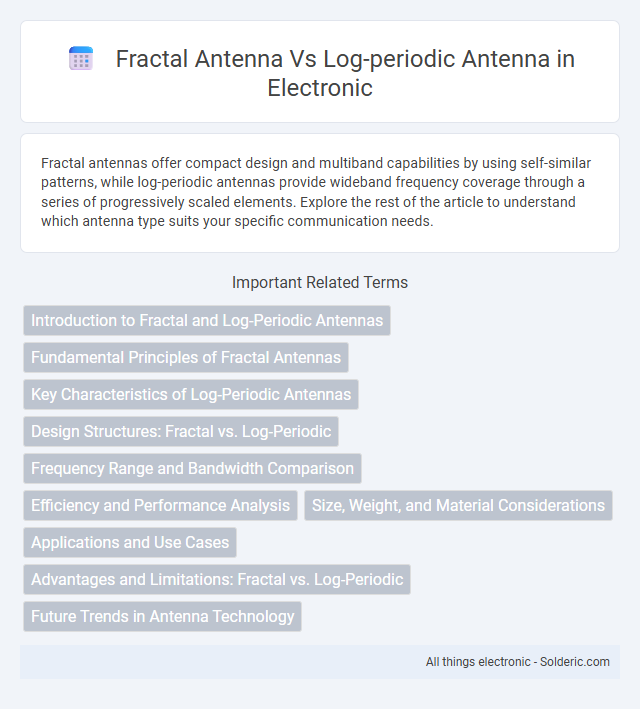Fractal antennas offer compact design and multiband capabilities by using self-similar patterns, while log-periodic antennas provide wideband frequency coverage through a series of progressively scaled elements. Explore the rest of the article to understand which antenna type suits your specific communication needs.
Comparison Table
| Feature | Fractal Antenna | Log-Periodic Antenna |
|---|---|---|
| Design | Self-similar, fractal patterns for compact size | Array of dipoles with logarithmic spacing |
| Frequency Range | Wideband, multi-band support | Ultra-wideband, covers large frequency spectrum |
| Size | Compact and space-efficient | Larger, due to multiple elements |
| Gain | Moderate, depends on fractal iteration | High, directional gain across bands |
| Radiation Pattern | Omnidirectional to moderately directional | Highly directional |
| Applications | Mobile devices, compact wireless communication | TV antennas, broadband communication, direction finding |
| Impedance Matching | Complex, requires tuning for multiple bands | Good, designed for impedance consistency |
| Manufacturing Complexity | Higher due to fractal shapes | Moderate, standard dipole array |
Introduction to Fractal and Log-Periodic Antennas
Fractal antennas utilize self-similar patterns to achieve multiband and wideband performance within a compact design, making them ideal for modern wireless communication systems. Log-periodic antennas consist of a series of dipole elements with varying lengths arranged logarithmically, enabling stable impedance and directional characteristics over a broad frequency range. Both types optimize frequency coverage, but fractal antennas emphasize miniaturization and multiband operation, whereas log-periodic antennas prioritize consistent performance across wide bandwidths.
Fundamental Principles of Fractal Antennas
Fractal antennas utilize self-similar patterns repeated at different scales, enabling compact design with multiband and wideband frequency response capabilities. These antennas enhance signal reception by maximizing the effective electrical length within a limited physical space, differing fundamentally from log-periodic antennas which rely on a sequence of elements scaled periodically to cover a broad frequency range. Your choice of antenna depends on space constraints and frequency requirements, where fractal designs provide efficient miniaturization without compromising performance.
Key Characteristics of Log-Periodic Antennas
Log-periodic antennas feature a multi-element design with elements of gradually varying lengths and spacing, enabling wideband frequency coverage and consistent impedance across a broad spectrum. Their directional radiation pattern provides high gain and reduced interference, making them ideal for applications requiring stable performance over numerous frequencies. You benefit from improved signal clarity and versatility in environments demanding multi-band reception or transmission.
Design Structures: Fractal vs. Log-Periodic
Fractal antennas feature self-similar, repeating patterns that enable compact designs with multi-band and wideband capabilities by efficiently utilizing space. Log-periodic antennas consist of a series of elements with progressively varying lengths and spacing, allowing consistent performance across a broad frequency range. Understanding these distinct design structures can help you choose the best antenna for your specific application requirements.
Frequency Range and Bandwidth Comparison
Fractal antennas exhibit multi-band and wideband frequency capabilities due to their self-similar, recursive geometry, enabling efficient operation over a broad frequency range with compact size. Log-periodic antennas provide ultra-wideband performance across a continuous spectrum, with a frequency ratio typically ranging from 3:1 to 10:1, making them ideal for applications requiring stable gain and consistent radiation patterns over wide bandwidths. The fractal antenna's bandwidth is often narrower on individual bands but covers multiple discrete frequencies, while log-periodic antennas maintain uniform impedance and radiation characteristics across the entire operational bandwidth.
Efficiency and Performance Analysis
Fractal antennas exhibit higher efficiency in compact designs due to their self-similar geometry, which enhances multi-band resonance and minimizes signal loss. In contrast, log-periodic antennas provide broader bandwidth and steady gain across a wide frequency range, making them ideal for consistent performance in diverse applications. Your choice depends on whether compact size with efficient multi-band functionality or wideband uniform performance is the priority for your system.
Size, Weight, and Material Considerations
Fractal antennas offer compact size and lightweight designs due to their space-filling patterns, making them ideal for applications with strict size constraints. Log-periodic antennas are generally larger and heavier because of their multiple elements arranged along a boom, requiring more material and structural support. Material considerations for fractal antennas emphasize flexible substrates for conformal installation, whereas log-periodic antennas rely on rigid metallic elements for structural integrity and consistent performance.
Applications and Use Cases
Fractal antennas excel in compact wireless devices, such as smartphones and IoT sensors, due to their multiband and wideband capabilities within a small footprint. Log-periodic antennas are primarily used in communications and broadcasting, including TV antennas and RF test equipment, offering consistent performance over a broad frequency range. Both antenna types support applications requiring frequency agility, but fractal antennas are preferred in size-constrained environments while log-periodic designs dominate high-gain directional uses.
Advantages and Limitations: Fractal vs. Log-Periodic
Fractal antennas offer a compact design with multi-band and wideband frequency capabilities, making them highly efficient for modern wireless applications, whereas log-periodic antennas provide consistent gain and impedance over a broad frequency range but are generally larger and more directional. The fractal antenna's intricate geometry allows for size reduction without sacrificing performance, but its manufacturing complexity and sensitivity to design parameters can pose challenges. Log-periodic antennas excel in reliable broadband performance and ease of tuning across frequencies, yet they tend to have increased physical size and reduced gain at the low-frequency end compared to fractal counterparts.
Future Trends in Antenna Technology
Fractal antennas offer compact size and multi-band capabilities due to their self-similar geometry, making them ideal for future IoT and 5G applications requiring efficient space utilization and wide frequency coverage. Log-periodic antennas continue to excel in broadband performance and high gain, supporting emerging requirements in satellite communication and radar systems where frequency agility and directional control are critical. Advances in materials, such as graphene and metamaterials, combined with AI-driven adaptive tuning, are expected to enhance both fractal and log-periodic antennas, enabling smarter, more flexible wireless communication infrastructures.
fractal antenna vs log-periodic antenna Infographic

 solderic.com
solderic.com